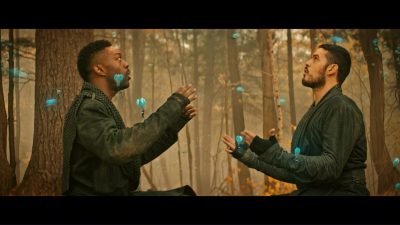
For the past two months, I have been exploring the religious elements of Star Trek: Discovery. Both seasons one and two have considerable religious elements. Of course that depends on how one exactly defines religion as well as how one interprets the actions of the characters. Season three is no different as the principle of connection becomes associated with religious rituals, behaviours, beliefs, and discussions.
By far, the most recognisably religious element of the season is the ritual bath that Adira participates in episode 4 in order to be able to commune (connect) with the symbiote. The ritual bath occurs in the sacred caves of Mak’ala. Adira, robed in white, enters the pool and spends considerable time learning to commune with the symbiote and its past hosts. After emerging from the pool of water, Adira is wrapped in a cloth that very much resembles a tallit.
As the host of a symbiote, Adira is also part of another storyline with religious aspects. (Adira comes out as non-binary in episode 8. Hence, the pronouns: they and them.) Their past boyfriend was Trill and host to the symbiote before them. Yet, unlike other past hosts, Gray appears to Adira in-person and not just as a memory. However, only Adira can see Gray, who is quite troubled by what is happening, specifically he wants to connect to others. He has this opportunity in episode 13, when the holo-program recognises him as a distinct entity. As a result, he connects with Hugh, who pledges to figure out how to bring Gray back. In this storyline of Gray, there are two religious elements at play: as an echo to last season, a part of Gray survived death; and, in line with this season, his yearning for connection.
Even before the storylines of Adira and Gray, one encounters Book, an empath who can commune with all sentient life. One example of how he communicates with and connects to sentient life can be found in episode 8. Book and his brother, Kyheem, another empath, pray together to save their home world. With the help of some amplification by Discovery, their words, “Sacred within me, sacred beyond me, be in harmony with me” reach the intended audience, convincing the sea locusts to return to the sea. Book’s connection to life also means that he feels everything. This is why he has become a conservationist, traveling the galaxy rescuing animals and bringing them to sanctuaries.
Georgiou is another example. In episode 5, we learn that she is dying. Not until episode 9 do we learn why: her travel in time as well as across universes. Hugh discovers with the help of the sphere data that there is a chance cure on Danas 5. Discovery travels there.
Michael and Georgiou beam down to the planet and while wandering in search of the cure, they discuss gods, death, and the afterlife. (While the conversation is different, this scene harkens back to the first episode of the entire series, when a different Georgiou and Michael wander in the desert.) Eventually, they meet Carl, a guardian of forever, who is standing next to a door. This whole scene seems contrived as an obvious philosophical/religious/moral test, both to the viewer as well as Georgiou and Michael. Nonetheless, Carl and Georgiou go back and forth as to why the door is there, are the right questions being asked, and so on.
Eventually, Georgiou steps through the door and ends up in the Terran universe much like we expected would happen. However, this time she behaves differently, seeking above all else connection with Michael. It is clear that her time with Discovery has changed her; she makes some progress with Michael and develops a strong bond with the Terran Saru. In the end, though, she once again kills Michael. Because of this, when Georgiou returns to the present, she assumes she has failed the test. On the contrary, Carl is forgiving and compassionate. He tells her that the connections she made saved many lives, who, in turn, will go on to save many more. Because of this, Carl offers Georgiou a connection portal to another life. She takes it.
Then, there is the burn. The burn put unsurmountable distances between people, both literally and figuratively. It almost completely destroyed the Federation, which in turn left peoples and worlds struggling and vulnerable. As a result, many lost their ability to trust. Saru alludes to this in episode 2, as does Hugh in episodes 4 and 13. Yet, a concrete explanation for the cosmic and spiritual effect of the burn only comes in episode 13. Michael says, “Disconnection, that is how this future began. One moment in time radiated outward until no one remembered that connection is possible anymore, but it is. The need to connect is at our core as sentient beings. It takes time effort and understanding. Sometimes it feels impossible. But if we work at it, miracles can happen…” And work at it, they have. Together, they discover how and why the burn happened as well as a new supply of dilithium. Now, both literally and figuratively, they can bring back what was lost: connection and trust.
There are three more examples in the season which speak to connection. First, in episode 8. Book references Martin Niemöller, when discussing who will intervene for Kyheem when he hasn’t stood up for the transworms or the locusts. Second, in episode 6, Hugh discusses how his understanding to and connection with life and death have changed given what he experienced last season. Finally, episodes 7 and 9 contain ethical discussions about one’s connection to and responsibility for others.
The theme of connection in Star Trek: Discovery’s third season runs deep. One can see examples in: the burn; Adira’s ritual bath to connect with the symbiote; Book’s connection to all sentient life; Georgiou’s attempts at connecting with the Terran Michael; Gray’s yearning for connection; and many others. At the same time, one cannot dismiss the ways in which these examples of connection are associated with religious debates, actions, beliefs, and rituals. In season three, connection is religious in nature.
May we… Live Long and Prosper.
This post concludes my three-part series. I hope to add a fourth part when they release the next season.
Ivy Helman, Ph.D.: A feminist scholar and faculty member at Charles University in Prague, Czech Republic where she teaches a variety of Jewish Studies, Feminist and Ecofeminist courses.





Is there any connection between this Star Trek you’re writing about and the Star Trek with Captain Kirk and Mr. Spock that I remember from the 1960s? That show was very popular, of course, and such shows grab us and hold on to us practically forever. Your new Star Trek seems to be as interesting as the older versions, of which there have been many. I’m not sure I ever watched any of the later versions of the series, though two of the later captains were actors I liked a lot. Are they still flying through space in the Enterprise?
LikeLiked by 2 people
Yes, the central character, Michael, is Mr. Spock’s sister. They are not on the Enterprise, they are on the Discovery, and they are flying through space. The Enterprise and Mr. Spock are part of season 2.
LikeLike
Thank you for this post! I have seen the third season, but hadn’t caught that thread of connection until you pointed it out. Now that you have, I also find it really interesting that they brought in the Guardian of Forever, which first appeared in the original Trek series episode City on the Edge of Forever. In that episode, Dr. McCoy, the ship’s doctor whose temperament was definitely not sentimental, inadvertently goes through the portal and ends up in 1930s New York, where, not remembering who he is, he falls in love with a peace activist. He changes history by preventing her death in a car accident. Because of her peace activism, the US enters World War II late and fascism wins, destroying the future of the whole galaxy. Kirk and Spock follow him back in time, before he saves her life, to convince him to let her die so that the whole galaxy can benefit. It is a mind-blowing episode and speaks to the sacrifice that love and connections sometimes require of us, which definitely are relevant to Discovery’s third season. I look forward to season four and your comments about it!
LikeLiked by 1 person